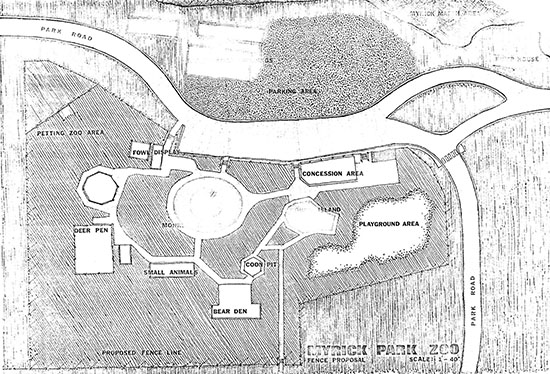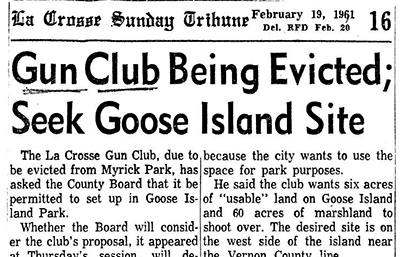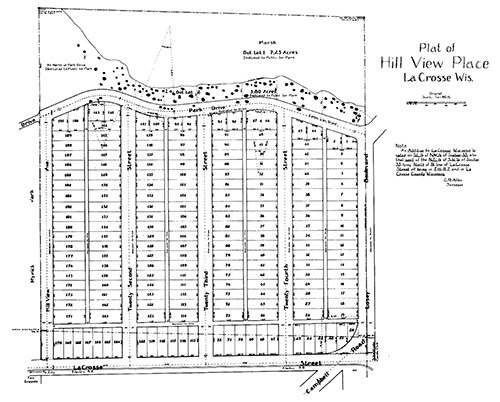
Myrick Park: A Hidden Gem
(written by Sam Steingraeber, Archives volunteer)
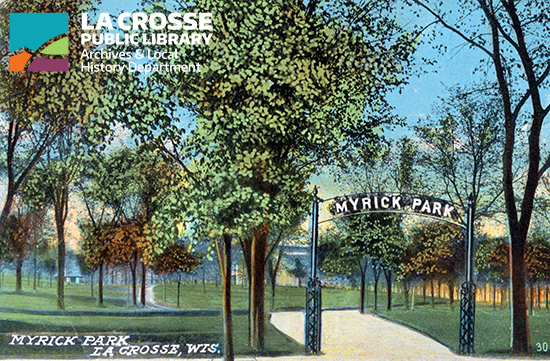
Myrick Park is a vibrant testament to the harmonious coexistence between urban life and natural beauty. Established in 1903, it is one of the first public parks in the region. Originally conceived as a way for residents to get away from city life, Myrick Park quickly evolved into a green oasis that has been utilized by generations of La Crosse residents. Over the decades, the park has witnessed numerous transformations, reflecting the changing needs and aspirations of the community it serves. The land itself has transformed and has been used for a multitude of different purposes such as entertainment, sport, nature education, and even burial sites.
The park is named after Nathan Myrick to honor him as the first white colonizer of the area. Myrick founded Prairie La Crosse in 1841, when he established a trading post to trade with the area Ho-Chunk and Dakota. He later bought a sawmill on the Black River and started selling lumber as well. He acquired a land title for a claim in La Crosse in a government land sale, had the land platted, and this became the first growth area for a rapidly growing river town. When Myrick left La Crosse in 1848 for St. Paul MN, the non-Indigenous population was around 20; fifty years later the town had grown to over 25,000. Check out our blog post for a more in depth look at Nathan Myrick.

Andrew Myrick (left) and Nathan Myrick (right). The portrait of Andrew Myrick is from the Minnesota Historical Society.
First, let’s examine one use of the land before it was ever called Myrick Park. Still visible today, there are multiple Indigenous burial mounds. These effigy mounds were created by the ancestors of the Ho-Chunk, circa 700-1100 AD, and were first excavated in the late 1880s by Frederic W. Putnam, an anthropologist who worked at Harvard University’s Peabody Museum of Archaeology and Ethnology. Putnam and his crew found ceramics, stone tools, nonhuman remains, and human remains. The remains and items found by Putnam were damaged, maybe from an earlier, less experienced archaeologist. Today only two of the mounds remain and can be viewed at the northern end of the park. When you are viewing effigy mounds, please be sure to respect them by not walking over them. To learn more, you can explore our History Club Activity from 2022 on the effigy mounds in Myrick Park.
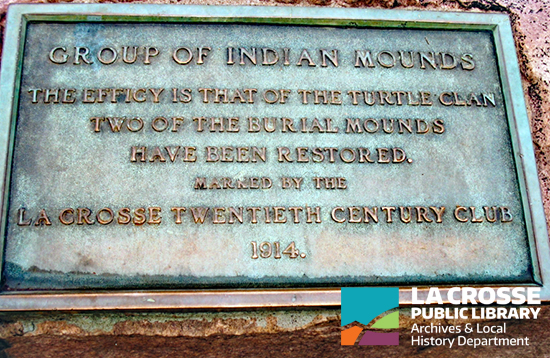
Plaque near effigy burial mounds in Myrick Park
Those who came later were also interested in using the land that became Myrick Park to access the natural resources that surround the area. The main resource that the city was interested in using Myrick Park for was access to water. Wells were drilled in Myrick Park from 1891-1893 helping to create the well system in La Crosse. In 1913, a new Water Utility building was built in Myrick Park that stands on the west side of the park to this day. Check out our blog post for a more in depth look at La Crosse’s effort for clean water.
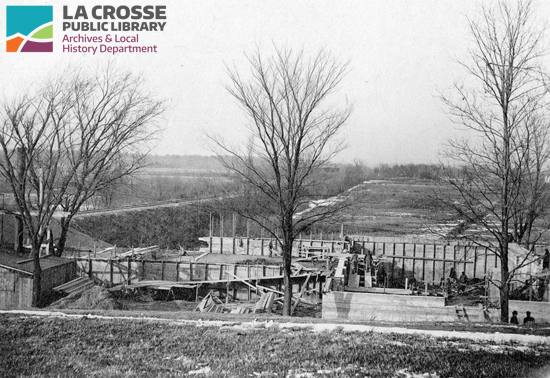
The Myrick Park Pumping Station under construction, looking northwest over the marsh. The Green Bay & Western Railroad tracks through the marsh are visible on the left of the photograph. From the papers of Milburn Gilbertson, MSS 098 held by the La Crosse Public Library Archives.
Myrick Park has been a place for people to get away from the city to enjoy and learn about nature. One of the most popular attractions was the Myrick Park Zoo, which opened in 1929 with the help of the local Veterans of Foreign Wars and fundraisers they had put on.
1928 petition to City Council, seeking to establish a free public zoo in Myrick Park - click for larger image
The Myrick Park Zoo featured attractions such as a duck pond, racoon pit, black bear den, bobcats, prairie dogs, peacocks, white tail deer, and monkeys. Ceck out our blog post to learn more about challenges of a municipality running a zoo without professionally trained zookeepers.
Rough map of Myrick Park Zoo from Parks and Recreation Department records - click image for larger view
There were more than just animals added to the zoo as well winter housing was added in 1952. A portion of the marsh was filled in to create a parking lot in 1955 and a petting zoo was created in 1977 featuring calves, geese, goats, rabbits, and fawns. Though the Myrick Park Zoo allowed the community to interact and learn about animals both native and exotic. Decades of concern over operating costs and how the animals were being treated led to the zoo closure in 2007, spurred by plans for a new Myrick Hixon EcoPark.

Monkey Island, 2006, shortly before its closure
After the decision was made to move away from the exotic zoo into a more native educational experience, the first idea was to create a playscape while keeping some native animals to appease those in the community who still wanted a Zoo in the park. The plan was to create five different playscapes including Wild Water, Prairie Maze, Forest Scramble, Invited Wildlife, and Farm Play. Unfortunately, several missteps throughout the process, including a lack of funding, unclear building plans, and even the threat of lawsuits over child safety on the playscapes, meant this idea never really got off the ground. These problems led to the City taking control over this area in 2014, including the newly built Myrick Park Center at the north end of the park, after Myrick Hixon EcoPark Inc. voted to back out of the project. This led to WisCorps taking over the environmental educational programing and renaming the Myrick Park Center the Nature Place, a nature center with year-round environmental educational classes as well as the capacity to serve as an event rental space.
Myrick Park has always had a close relationship with the marsh system that sits just to the north of the park. As mentioned earlier, the park has even taken over marsh land through fill in programs to create more useable land in the park. One group that wanted to continue the push into the marsh was the La Crosse Gun Club. The gun club started utilizing the north end of the park in 1943 for trap shooting. As the years went on and the park started being used by more and more people there were disagreements that started to crop up between the Gun Club and outside groups. These disagreements include noise complaints from neighbors of the park, the city wanting to expand the park north into the marsh, and the cost of insuring club members as more and more people started to utilize the public spaces in the park. After several years of negotiation, it was decided that it would be best if the La Crosse Gun Club found a new home and in 1961, they left the park. One of the remnants of the gun club can be seen in the gun club shelter that is still standing at the North end of the park.
Click image for full article
Entertainment has also played a role in shaping Myrick Park. People use the park as a place to have fun and escape their troubles. There have been multiple structures built in Myrick Park whose purpose was to share music. In 1894, a Band Stand was erected with funding help from the La Crosse City Railroad Company under the condition that the Railroad Company could hold dances there and be allowed to serve temperance drinks. Even when the park did not have a permanent music area there was discussion at park meetings on purchasing a portable band shelter. A second music pavilion was built in 1906. In this pavilion, La Crosse Normal School Joseph Clauder’s Military Band and the radio station WKBH broadcast their “Kiddie Hour” program from 1924-1955 in the park.
Kids Coulee, a large playground and amphitheater with a variety of structures offering challenges and to children of all ages, is another entertainment feature of Myrick Park. The way it was built in 1994 is as interesting as the playground itself. The Rotary Club of La Crosse thought that the Myrick Park area lacked a proper playground. Through fundraising efforts, they were able to raise $278,000 to purchase the materials for Kids Coulee, but the more interesting part is who took part in building the playground. Around 3,700 volunteers, from college students to local business people, took part in the construction of the playground and amphitheater over a couple of days during the summer. After nearly 3 decades, updates to Kids Coulee were completed in early 2024, including restoring rotted wood and adding new playground equipment to the existing structure.
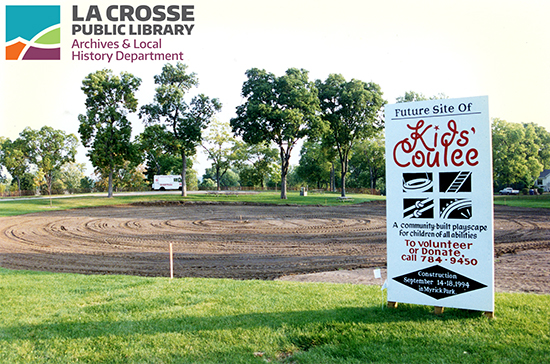
Myrick Park space prepared for Kids Coulee construction, 1994
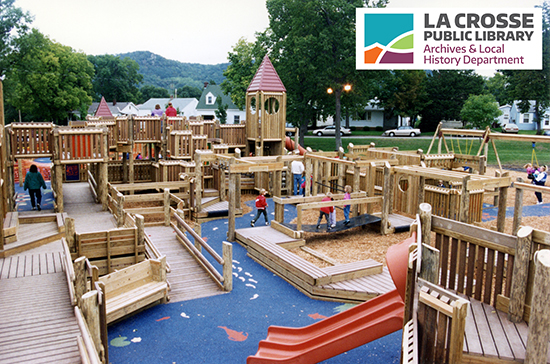
Kid's Coulee playground, 1994
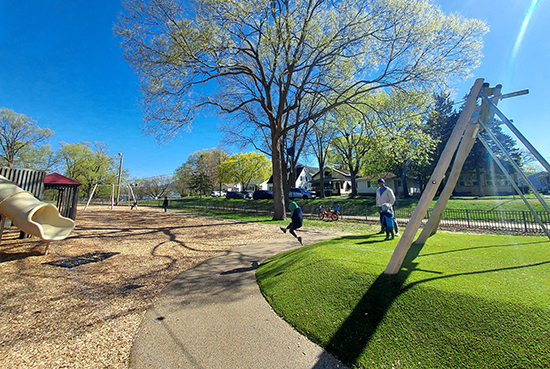
New zipline at Kid's Coulee playground, 2024
Myrick Park is a testament to the commitment of the community to have available public green spaces. This is evident by examining the developments that surround the park. To the east there is a housing development named Hill View Place. In the late 19th and early 20th centuries, this was farmland owned by L.F. Easton. It was plotted out for residential development in 1907 and Easton started selling plots. It is interesting to note that the first house built in the area that would have had a park view is 721 22nd Street North, prior to homes on Hillview Ave being completed. The first house that actually neighbored the park was 716 Hillview Ave. As expected, parcels of on Hillview Ave. bordering the park were more valuable and sold for $200 while those farther away were sold for $175 or less.
City Plat of Hill View Place Addition, 1907 - click for larger image
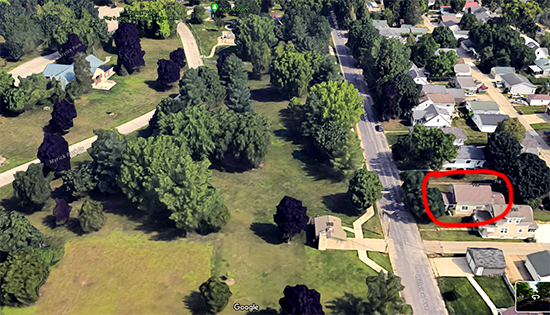
716 Hillview Ave, first home built in Hill View Place Addition that bordered Myrick Park. Image courtesy of Google Street View, modified for effect.
To the west of Myrick Park is Oak Grove Cemetery. G.E. Strasberger bought the land in 1869, but he quickly ran into the problem of running out of space and added 19 acres of land to the existing cemetery slowly moving it closer to what would become Myrick Park. In 1872, the Oak Grove Cemetery Association purchased the cemetery and an additional five and a half acres making the total space thirty-two acres. Then in 1909 the cemetery expanded once more and jumped what was the Green Bay and Western Railroad line, which now is East Avenue North, to border on Myrick Park where it remains today. Check out our blog post to learn more about the beautification of Oak Grove Cemetery.
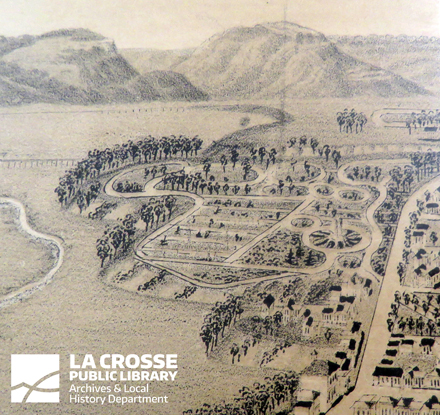
Oak Grove Cemetery in 1887 Birdseye View of La Crosse
The third development encroaching from the south onto Myrick Park is the University of Wisconsin-La Crosse. The La Crosse Normal School opened in 1909 as a school for training public elementary and secondary school teachers. It has evolved and grown ever since, adding more and more buildings and spreading east, north, and west from its first building on the corner of State Street and Campbell Road. With all these changes and the growth in student population, the university has always looked for new ways to expand. In the 1970s, UW-L proposed a plan to fill in 60 acres of marshland to build a stadium, ice rink, baseball fields, a lake, and beach. After consideration and public feedback, a compromise was made and 8 acres of marshland were allowed to be filled in to create the North Campus Fields and the Facilities Management office north of Oak Grove Cemetery and west of Myrick Park.
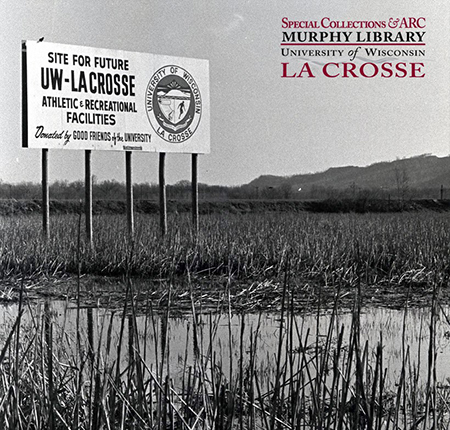
Myrick Park has had a variety of diverse and unique uses throughout the years standing as evidence for the La Crosse community’s dedication to open spaces. Myrick Park is not only a retreat from city life into nature but also as a community space providing essential services to residents and visitors alike. Myrick Park serves as a reminder of how a community can recycle and revitalize the space it has into different projects to help fit the needs of the community as the community evolves.


